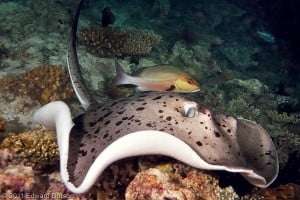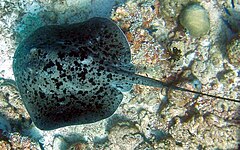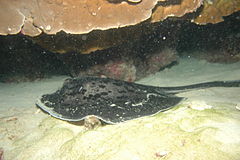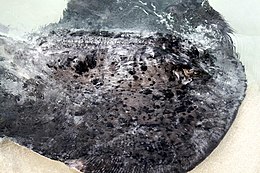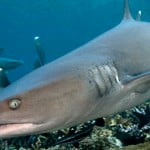The Giant reef ray (Taeniurops meyeni) is a species of stingray in the family Dasyatidae, found throughout the nearshore waters of the tropical Indo-Pacific, as well as off islands in the eastern Pacific. It is a bottom-dwelling inhabitant of lagoons, estuaries, and reefs, generally at a depth of 20–60 m (66–200 ft).
Reaching 1.8 m (5.9 ft) across, this large ray is characterized by a thick, rounded pectoral fin disc covered by small tubercles on top, and a relatively short tail bearing a deep ventral fin fold. In addition, it has a variable but distinctive light and dark mottled pattern on its upper surface, and a black tail.
Generally nocturnal, the Giant reef ray can be solitary or gregarious, and is an active predator of small, benthic molluscs, crustaceans, and bony fishes. It is aplacental viviparous, with the embryos sustained by yolk, and later histotroph (“uterine milk”) secreted by the mother; up to seven pups are born at a time.
Although not aggressive, if provoked the Giant reef ray will defend itself with its venomous tail spine, and it has been responsible for at least one fatality.
It is valued by ecotourist divers and recreational anglers. This slow-reproducing species is threatened by commercial fishing, both targeted and as bycatch, and habitat degradation across much of its range. As a result, the International Union for Conservation of Nature (IUCN) has assessed it as Vulnerable.
Description
The blotched fantail ray has a thick pectoral fin disc wider than it is long, with a smoothly rounded outer margin. The eyes are of medium size and are followed by larger spiracles. There is a short and broad curtain of skin between the oval nostrils, with a finely fringed trailing margin. The mouth is wide and curved, with faint furrows at the corners. There is a row of seven papillae on the floor, with the outermost pair smaller and set apart from the others.[7] There are 37–46 tooth rows in the upper jaw and 39–45 tooth rows in the lower jaw.[10] The teeth are small with a deep groove across the crown, and are arranged in a dense quincunx pattern into flattened surfaces.[9]
The pelvic fins are small and narrow.[7] The tail is relatively short, not exceeding the width of the disc, and bears one (rarely two) long, serrated stinging spine on the upper surface. The base of the tail is broad; past the spine the tail rapidly thins, and bears a deep ventral fin fold that runs to the tail tip.[7] The upper surface of the disc and tail are roughened by a uniform covering of small, widely spaced granules. There is also a midline row of sharp tubercles on the back, with two shorter rows alongside. The first of these tubercles develop at a length of around 46 cm (18 in), over the “shoulders” and in the single midline row.[9]
The dorsal coloration is light to dark gray, brown-gray, or purplish, becoming most intense towards the fin margins, with a highly variable pattern of irregular darker mottling and white speckles or streaks. The tail past the spine, including the fin fold, is uniformly black, while the underside is creamy white with darker fin margins and additional dots. Young rays are more plain in coloration than adults.[9][11] One of the largest stingray species, the blotched fantail ray can grow to 1.8 m (5.9 ft) across, 3.3 m (11 ft) long, and 150 kg (330 lb) in weight.
Biology and ecology
The blotched fantail ray is relatively inactive during the day, often resting on sand near reef structures.
Little information is available on the life history of the blotched fantail ray. Like other stingrays, it is aplacental viviparous: the unborn embryos are initially sustained by yolk, which is later supplemented by histotroph (“uterine milk”, containing proteins, lipids, and mucus) produced by the mother.[3] Reproductive aggregations numbering in the hundreds have been observed at Cocos Island shortly after the onset of La Niña, which brings cooler temperatures. During these periods a single female may be pursued by dozens of males.[12]Females bear litters of up to seven pups, each measuring 33–35 cm (13–14 in) across and 67 cm (26 in) long.[1] Off South Africa, birthing may take place in the summer.[17] Males attain sexual maturity at a disc width of 1.0–1.1 m (3.3–3.6 ft); the maturation size of females is unknown.[1]
Human interactions
The International Union for Conservation of Nature (IUCN) has assessed the blotched fantail ray as Vulnerable. It cannot withstand heavy fishing pressure due to its low reproductive rate, and there is widespread degradation of its coral reef habitat, including from agricultural runoff and destructive fishing practices such as blast fishing. This species is caught by commercial and fisheries throughout its range, using line gear and trawls. One region where it is heavily pressured is in Indonesian waters, where it and other large rays are taken intentionally and otherwise by tangle netters, longliners, and trawlers operating off Java, Bali, New Guinea, and Lombok. All landed individuals are brought to market for human consumption.[1]
Off South Africa, the blotched fantail ray is captured incidentally by prawn trawlers on offshore banks, but is not utilized. Because of its size and strength, it is also prized by sport anglers, who usually release it unharmed. South Africa sets a recreational bag limit of one ray per species per person per day, and does not allow spearfishing for this species.[1][17] In Australian waters, this ray has been assessed as of Least Concern. Although it is caught (and discarded) by prawn trawlers, this mortality has been reduced by the mandatory installation of Turtle Excluder Devices (TEDs). Furthermore, a portion of its Australian range lies within the Great Barrier Reef Marine Park. This species has also been listed under Least Concern in theMaldives where, due to the tourist value of rays, the government has created protected marine reserves and banned the export of rays in 1995 and ray skins in 1996.[1]
